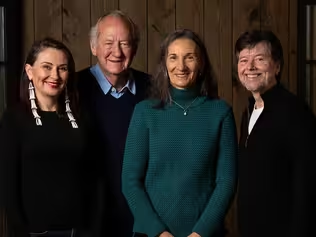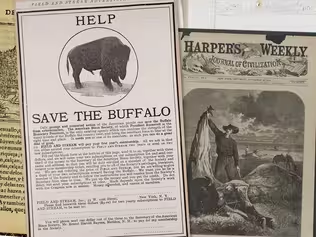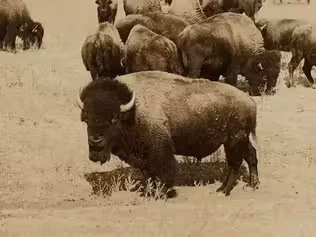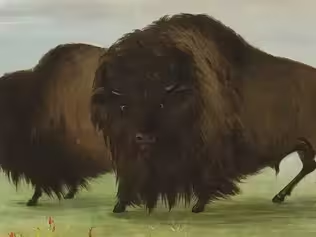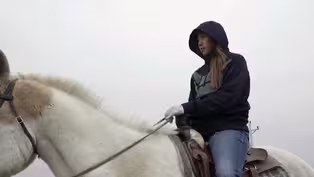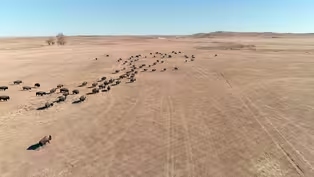
Bring Them Home
Clip: Special | 18m 44sVideo has Closed Captions
An intimate look at the only indigenous tribal-led buffalo drive in North America.
An intimate look at the only indigenous tribal-led buffalo drive in North America, Bring Them Home follows members of the Blackfeet Nation as they experience the power of the American bison while driving their herd through rough terrain and hostile weather to their winter pasture --a rare ritual of stewardship that brings hope for a modern-day cultural rebirth.
Problems playing video? | Closed Captioning Feedback
Problems playing video? | Closed Captioning Feedback
Corporate funding for The American Buffalo was provided by Bank of America. Major funding was provided by the Corporation for Public Broadcasting, and by The Better Angels Society and its...

Bring Them Home
Clip: Special | 18m 44sVideo has Closed Captions
An intimate look at the only indigenous tribal-led buffalo drive in North America, Bring Them Home follows members of the Blackfeet Nation as they experience the power of the American bison while driving their herd through rough terrain and hostile weather to their winter pasture --a rare ritual of stewardship that brings hope for a modern-day cultural rebirth.
Problems playing video? | Closed Captioning Feedback
How to Watch The American Buffalo
The American Buffalo is available to stream on pbs.org and the free PBS App, available on iPhone, Apple TV, Android TV, Android smartphones, Amazon Fire TV, Amazon Fire Tablet, Roku, Samsung Smart TV, and Vizio.
Buy Now
Providing Support for PBS.org
Learn Moreabout PBS online sponsorship♪ ♪ ♪ ♪ EDMO: Growing up, we've, you know, we've all heard about, you know, the buffalo, you know, being so important to the Blackfeet.
It was our life way, and we were told that, and I was told that, and I learned that in school, and I didn't know what that meant, um, culturally.
And so now, um, I feel like, you know, we're getting a little piece of us back.
♪ ♪ (bellowing).
(bellowing).
GLADSTONE: Okay, so first...
It's an honor, you know, and when I get chances to do this, it's fun.
You know, it's like, you know, being a part of the, uh, Buffalo Drive is, it's more of a, uh, honor than anything else.
ERVIN: So, we move these animals today, uh, getting ready to move them back to, uh, to the wintering grounds.
And a lot of those people that, um, that we do have out there helping, they're, um, simply volunteering.
They're glad to see these animals back and glad to see a part of our, uh, or a big part of our culture back.
GLADSTONE: Herding buffalo is a new thing to our people, you know?
A decade ago, this wasn't happening.
So, you know, hopefully, for the next seven generations, you know, we'll keep this herd going and we'll have thousands out here.
(engine rumbling) ♪ ♪ EDMO: The buffalo just started out, you know, charging more or less, like they were, um, really anxious to get, you know, where they needed to go.
You know, it's pretty humbling.
You know, I used to think that, um, just being on horseback alone was safety enough, but it really isn't.
Like, you have to pay attention and stay back and be alert 'cause they could run, you know, run you down.
They need their space and they, they demand their space.
♪ ♪ ERVIN: You get started, it's, um, is a little chaotic.
They're not, um, animals to be herded.
So, they gonna wanna go, you know, where they want to go.
SHELDON: I wanted to slow down 'cause we had old cows and all that, 'cause we had some that didn't cross the highway, and they were going crazy, they're panicking, "Where's the herd, where's the herd?"
So, they're gonna jump whatever and that's what happened, they started jumping fences.
(grunts).
So, it's, it's a tough day!
Yeah, I'm gonna have to come back here.
GLADSTONE: We got them through the first area and we kinda got them in, pushed into one section and they kinda went through a fence, kinda yeah, they went through a fence and we had, had to get them the other direction.
It was kinda a bit confusing at the first.
ERVIN: Well, yeah, as you started out, you know, it, it's, it's a little, uh, a little rough, a little chaotic getting them all lined out like I said earlier.
But, uh, once we got into the afternoon, it was, um, things all kinda smoothed out and we were able to get going good along the trail, I guess.
When you're doing stuff with them, there's, you know, unfortunately, we're gonna have, um, you know, some fatalities.
She was an older cow and just got a little too overheated and, um, you know, on the run too much and, and, um, and her heart, uh, gave up.
When she died, then her calf, um, you know, stayed with her and, and the herd just moved on.
SHELDON: Well, the way I look at that is that he realized his mom died and the only way he's gonna have protection is get back to that herd.
And that's the hardest thing on calves, is walking away and, and continue staying with that herd because that's their protection.
You know, that's the way I look at it.
It's just like how we are, you know?
We, we get our kids in place to where if something ever happened, they still know what to do, how to take care of themselves to continue go on with life.
And I felt bad after she died, maybe she offered her life to cover everything.
Maybe that's what the purpose was for.
You know, we can't look at it, it, like it's a bad thing or anything like that, you know, that's life.
♪ ♪ GLADSTONE: Being on horseback is better than being on four-wheeler or pickup truck or anything like that.
So, when the horse is, the horse is running and you're going full-throttle on your horse and you got the buffalo beside you and you hear the hoofs just trampling the ground, the adrenaline rush going through your body is just un, unimaginable, and you know, that, that, that feeling alone is I get back, I get from back here, back home, back to the reservation.
Being a part of this is, you know, a life-changing experience, it has been for me.
♪ ♪ Ow!
♪ ♪ ♪ ♪ (fire crackling).
AUGERE: We have a lot of stories and a lot of, um, ceremony that involve the iiníí.
Iiníí is what people call the buffalo or the bison, to us it's iiníí.
They taught us what to eat, how to hunt, they were the ones who taught us how to live.
ERVIN: You know, I always, I always talk about, um, how us, as a tribe, many people being, um, one in the same as, as, as buffalo.
Buffalo were killed off to make way, you know, make way for the settlers, for their cattle.
And I, I believe that's the way that it kinda went the same with, with us as Indian people.
We needed, they needed to get us out of the way; both the buffalo and the Indian, to, to make way for the settlers to come in here.
And buffalo now are, uh, they're restricted to areas, um.
You see all the other wildlife; elk, deer, they can come and go as they please, everywhere.
But, uh, buffalo, they won't let them come and go as they please.
And that's the way they were with, uh, in our beginnings, putting on reservations, weren't allowed to leave.
And so, we, we had that same, same fate.
AUGERE: And today, the challenge is not how iiníí takes care of us, but how we're gonna take care of iiníí.
We tend to talk about iiníí as part of our past, but he's very much part of our future.
♪ ♪ ♪ ♪ GLADSTONE: In the second day, Old Man Winter came knocking at the door a little early and stuff.
And so, we all had to get geared up and we actually got a chance to, uh, you know, battle the elements.
SHELDON: The weather was bad but I can't say it, it's bad because I will not hold them in a, in a, in a field more than, longer than two days.
If it was storming like crazy, I'd still have to keep pushing them.
'Cause if I don't, they're gonna go it themselves.
They're not gonna wait for us, they're just gonna continue going, then that's where you end up with people hitting them with cars.
So, that's why I just kept pushing.
♪ ♪ ♪ ♪ ♪ ♪ VAILE: Coming out here, and it's hard work, but I, I love that part.
Last night, it felt like a Mack truck hit me when I sat down and relaxed for a few.
But it was really rewarding and, and it was a good feeling.
EDMO: The buffalo has been really key in uniting our community and such, and affecting us in such a positive way.
ERVIN: For this certain time, I'll, I'll bringing these animals back and forth through the winter and, and summer, uh, ranges it's brings people together and creates that community, uh, togetherness.
These animals created that.
They've created a lot of things along the way that I've seen.
♪ ♪ (gusting winds).
(bellows).
SHELDON: I feel like, they're like hurt because we have to pen them.
It's just a natural thing in their mind that they roam wherever they wanted to go back then, you know, nothing stopped them.
And if they didn't have fences here, they'd already have been home a month ago, and they'd already be working their way back up here just for the heck of it.
ERVIN: And that's, that's really how buffalo should be is be able to, uh, roam free just like other wildlife and we want to see buffalo accepted like that, to be wildlife as they should be, and be able to roam, you know.
Might not ever be but, uh, it's kinda always been a big dream of mine is to, that to happen.
(overlapping chatter).
ERVIN: When we get to the gate, we'll have somebody at the gate, to open it... And then the only thing that you have to do is just, just yell at them, "Gate!"
If you yell at them, "Gate," they know to go through that gate, yeah?
MAN: And I just remembered what Landon said yesterday.
He prayed and he said, "This is my field, pray that everybody is safe.
Nobody gets hurt."
(engine rumbling) ♪ ♪ ♪ ♪ ♪ ♪ ♪ ♪ ♪ ♪ MAN: Gate!
Gate!
Gate!
Gate!
Gate!
Gate!
(gusting wind).
MAN: Gate!
(gusting wind).
♪ ♪ EDMO: I hear stories about how like the older people would always say that the buffalo would never come back.
You know, they, because they were part of that era where there were no buffalo being here on the reservation.
Now, you know, there's buffalo conservation is happening everywhere and it really gives us hope.
ERVIN: I always have that feeling of, I want to be a part of helping make things better, you know, for our people, and now, helping make things better for our buffalo.
It's a real big thing for me and now a lot of our people, to, uh, to actually see them buffalo back here on our lands where they were gone for so many years.
And then my thought is that, um, I want to see them here on this land, you know, for, you know, generations to come.
For all of my, my kids, my grandkids, my great grandkids, you know, I want them animals to be here for the, our future generations.
♪ ♪ (chanting) (chanting) (chanting through credits)
Video has Closed Captions
Clip: Special | 9m 30s | Iniskim follows a young woman’s journey to recovery by reconnecting with the buffalo. (9m 30s)
Video has Closed Captions
Clip: Special | 5m 51s | The Rosebud Indian Reservations Wolakota Project aims to bring the buffalo home. (5m 51s)
Providing Support for PBS.org
Learn Moreabout PBS online sponsorshipSupport for PBS provided by:
Corporate funding for The American Buffalo was provided by Bank of America. Major funding was provided by the Corporation for Public Broadcasting, and by The Better Angels Society and its...

